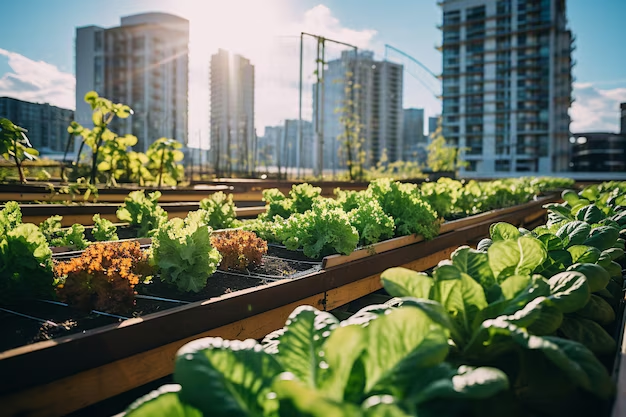Embracing Green Spaces: Urban Farming's Impact on Low-Income Neighborhoods 🌿
In recent years, urban farming has emerged as a powerful tool for revitalizing low-income neighborhoods worldwide. This movement isn't just about growing food; it's about transforming communities, fostering sustainability, and empowering residents. Today, we dive into how urban farming is reshaping these neighborhoods, the challenges it faces, and why it's becoming a beacon of hope in urban environments.
The Roots of Urban Farming: Where It All Began
Urban farming, defined as the practice of cultivating, processing, and distributing food within urban areas, isn't a novel idea. Its roots can be traced back centuries, as farming in cities was a necessity before modern transportation. However, recent global and local challenges, such as food insecurity, climate change, and economic stress, have propelled urban farming into the limelight once again.
Why Urban Farming? A Look at its Multifaceted Benefits
Food Security and Access: In many low-income neighborhoods, fresh produce is scarce or expensive. Urban farms bridge this gap, offering residents affordable access to healthy food.
Community Engagement: Farms bring people together, fostering community bonding and cooperation. They serve as educational platforms for children and adults, raising awareness about food systems and sustainability.
Environmental Impact: Urban agriculture supports biodiversity, reduces the urban heat island effect, and decreases food miles, which contributes to reduced carbon emissions.
Economic Opportunities: These farms create jobs and micro-businesses, from selling produce at markets to offering workshops and tours.
Overcoming the Challenges: What Holds Urban Farming Back?
While urban farming offers numerous benefits, it's essential to recognize the hurdles it faces, especially in low-income areas.
Space and Resources
Limited space in densely packed neighborhoods makes finding suitable land a challenge. Creative solutions, such as rooftop gardens or vertical farming, are often essential. Moreover, securing water, soil, and equipment requires funding, often a significant hurdle for communities lacking resources.
Policy and Regulation
Urban farming can sometimes run afoul of city regulations, from zoning laws to health and safety codes. Navigating the bureaucratic landscape can be daunting for budding urban farmers.
Sustainability and Resilience
Ensuring that urban farms are sustainable long-term requires planning, education, and support. Access to expertise and ongoing training is crucial to maintain productivity and ecological balance.
The Human Element: Stories from the Field
In cities around the world, urban farming has become a lifeline for many communities. Consider these inspiring examples:
Community Gardens in Detroit: Once known as the automotive hub of the U.S., Detroit is now making headlines for its flourishing community gardens. These spaces have become hotbeds for cultural exchange and empowerment, allowing residents to share stories and strategies while working the land.
Vertical Farms in Singapore: This futuristic city-state, with its space constraints, has embraced vertical farming. These high-tech installations are producing leafy greens year-round, providing fresh produce to lower-income residents at a reduced cost.
How to Start an Urban Farm: A Practical Guide 🥕🌱
For those inspired to ignite change in their neighborhood, starting an urban farm can seem daunting. Here's a concise guide to get you started:
Assess Your Space and Needs:
- Look for available land, rooftops, or community spaces.
- Identify the community's needs—what produce is most beneficial?
Engage with the Community:
- Host meetings and workshops to gather support and ideas.
- Collaborate with local organizations and non-profits for resources and expertise.
Navigate Legal and Regulatory Hurdles:
- Research local zoning laws and seek necessary permits.
- Consult with city officials to ensure compliance.
Plan for Sustainability:
- Consider irrigation solutions, composting, and soil health.
- Develop a management plan to maintain the farm long-term.
Education and Training:
- Provide ongoing education for participants to ensure the farm thrives.
- Incorporate lessons on gardening, environmental stewardship, and nutrition.
A Vision for the Future: Toward a More Sustainable Urban Landscape
The emergence of urban farming in low-income neighborhoods marks a significant shift toward creating sustainable, equitable urban environments. While challenges remain, the potential benefits far outweigh the obstacles. These green spaces offer a glimpse into a future where food is grown sustainably, communities are strengthened through collaboration, and cities are resilient against global challenges.
Key Takeaways and Next Steps 🌟
- Urban farming is more than food production—it's about building community and promoting sustainability.
- Challenges exist but can be overcome with creativity, community engagement, and support from local authorities and organizations.
- Starting a farm requires planning and collaboration but offers endless possibilities for personal and communal growth.
Here's to greener futures, healthier environments, and stronger communities brought together by the collective effort to cultivate the land we live upon. 🌿

Related Topics
- A Comprehensive Guide To Community Cooperative Childcare: A Grassroots Solution
- A Guide To Online Second-Hand Shopping: Platforms, Tips, And Tricks
- Affordable After-School Programs And Clubs: A Complete Guide
- Affordable Group Therapy: Benefits And How To Find
- Affordable Natural Therapies For Mental Well-being
- Avoiding Financial Scams And Pitfalls: A Comprehensive Guide
- Backpacking On a Budget: A Guide For The Minimalist Traveler
- Beginners Guide To Thrifting: Stretching Your Dollar Further
- Beyond Clothing: Thrifty Finds For Home And Kitchen
- Budget-friendly Garden Start-ups: From Seeds To Harvest